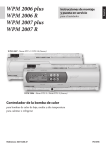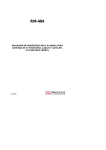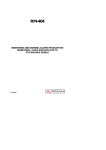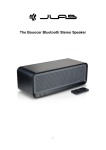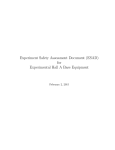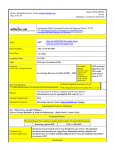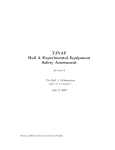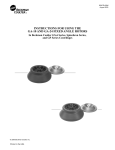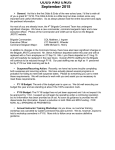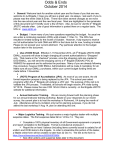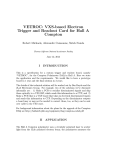Download User Manual - Jefferson Lab
Transcript
Vertical Test Area Personnel Safety System Users Guide Revision 2 May 10, 2004 Prepared by the JLab Safety Systems Group i Table of Contents 1 THINGS TO KNOW ............................................................................................................ 2 2 REFERENCE DOCUMENTS............................................................................................. 2 3 INTRODUCTION................................................................................................................. 2 3.1 HAZARDS ......................................................................................................................... 4 3.2 MITIGATION ..................................................................................................................... 4 3.3 ADMINISTRATIVE PROCEDURES / ASSUMPTIONS ............................................................. 5 3.4 DIFFERENCES BETWEEN THE VTA/CPTS PERSONNEL SAFETY SYSTEM AND THE CEBAF PERSONNEL SAFETY SYSTEMS. .................................................................................................... 5 4 STAFFING ............................................................................................................................ 6 5 PSS LOGBOOK.................................................................................................................... 6 6 PSS EQUIPMENT ................................................................................................................ 7 6.1 6.2 6.3 6.4 6.5 6.6 6.7 6.8 7 PSS STATUS PANEL ......................................................................................................... 7 RF MUX CHASSIS ........................................................................................................... 7 DEWAR LAYOUT .............................................................................................................. 8 AC SWITCH BOX ............................................................................................................. 9 MAGENTA BEACON........................................................................................................ 10 AUX. CRASH PANEL ...................................................................................................... 10 RF SWITCH BOX ............................................................................................................ 10 RADIATION MONITOR ALARMS ..................................................................................... 11 VTA OPERATION............................................................................................................. 12 7.1 VTA OPERATOR REQUIREMENTS .................................................................................. 12 7.2 PSS OPERATION ............................................................................................................ 12 7.2.1 Enabling High Power RF Amplifier AC Power ................................................... 12 7.2.2 PSS Trips .............................................................................................................. 13 7.2.3 RF Enable.............................................................................................................. 13 7.2.4 Emergency Crash Switch (ESTOP) ...................................................................... 13 7.3 RF CABLE CONFIGURATIONS......................................................................................... 14 7.3.1 Dewar High Power RF Configuration .................................................................. 14 REVISION HISTORY ............................................................................................................... 16 VTA PSS User Manual-rev2 1 Revision - 0 5/11/04 2 Things to Know All PSS devices are under personnel safety configuration control. Only Safety System Group personnel may access, modify, or alter these devices. Activating ANY crash switch will shut off ALL RF sources. 2 Reference Documents JLAB VTA PLC Logic Specification JLAB VTA Standard Operating Procedure 3 Introduction The VTA is the cold test facility for prototype and production versions of both 805MHz and 1497MHZ RF cavities. Low and high power amplifiers are used for testing, however only the high power amps have the potential to produce hazardous ionizing and non-ionizing radiation. The VTA Personnel Safety System is an engineered interlock system to help protect personnel from exposure to prompt ionizing radiation (PIR) and radio frequency non-ionizing (microwave) radiation that results from operation of the VTA test dewars in the JLab SRF test lab building (building 58). The Personnel Safety System must be able to ensure that high power RF is only allowed to operate when the RF systems are configured to safely do so. Also, ionizing and nonionizing (RF) radiation monitors are located near areas that would be most likely affected by improper or unanticipated operation of the dewars. If a fault is detected on one of these systems, all RF sources are shut off. Other PSS conditions for successful operation of high power RF include no area radiation alarms and proper configuration of the RF switching systems. The VTA PSS consists of: • Dewar shield interlocks • Dewar radiation monitors • Dewar radiation warning beacons • Area radiation monitors • Area radiation warning beacons • Area radiation audible alarm • PSS PLC logic control system located in the PSS rack • PLC logic program that runs on each of two PLCs. • Production Amplifier rack AC contactors • Dewar PSS AC power contactors located on the front of dewars 3 through 8. • Dewar RF Switch box located on the front of each of dewars 3 through 8. • PSS Status Panel chassis located in the PSS rack. • PSS RF Mux Chassis located in the PSS rack. • PSS Emergency Crash (ESTOP) switch located in the R&S control room. • All PSS conduit, cable, and wiring. VTA PSS User Manual-rev2 Revision - 0 5/11/04 3 In addition to these devices the RF mux switching systems located in the production amplifier racks are not owned by the PSS but are under PSS configuration control. There are two methods of delivering high power RF to a dewar device under test. The first method uses a dedicated production RF switching and high power amplifier system located in rack #24 in front of dewar 6. The output of a RF amplifier can be routed via a RF switching system to the desired dewar device under test. The 805 MHz production amplifier can be routed to dewars 7 or 8. The 1497 MHz production amplifier can be routed to dewars 3 through 8. The second method of delivering high power RF to a dewar device under test is route a local high power RF amplifier through the RF Switchbox located on the front of each dewar. The RF switch box contains a 1 Watt amplifier and coaxial high power RF switches to route either the low power (< 1Watt) or high power to the dewar. Also on the front of each dewar are two PSS controlled AC power receptacles, one for 208V three phase, and one for 120V single phase. Under no circumstances should an operator route the output of a high power RF amplifier directly into a dewar device under test. Pre-routed high power RF cables are available from the production amplifier systems and from the RF Switchbox RF output into each dewar. At least two independent guard lines are used to shut systems down in the event of an unsafe condition. Comprehensive testing of the interlocks in accordance with the VTA PSS Test Procedure is to be performed semiannually in order to assure that no failed component in the interlock system is left in place during operations. Additional testing of the interlocks for individual dewars may be performed before each RF test. The interlock system includes area radiation monitors, (RM401-RM403). Each of these monitors can have up to three probes. If the radiation level at any one of these monitors exceeds its preset "high" level, the monitor will open the guard line and an audible alarm will sound in the control rooms and in the VTA dewar area. The radiation monitor alarm will continue until both the alarm condition is returned to normal and the Reset button is pushed on the PSS Status Panel. Additional radiation monitors are located inside each of the testing enclosures (RM404-405). If the radiation level at any one of these monitors exceeds 1.0 mR/hr while that enclosure is open, the monitor will open the guard line and the alarm will sound. When the enclosures are shut, these monitors provide an indication of radiation present at the cryostat top plate area. The radiation monitor guard lines must be complete to enable introduction of RF power at any level into a cavity cryostat. In addition, the output of a high power (>1 watt) RF amplifier may only be routed to a test enclosure while that enclosure is shut. A change to the version 2.0 VTA PSS logic is that any radiation monitor alarm will shut off ALL RF devices interlocked through the PSS. Version 1 logic would only shut off RF to the dewar associated with the alarm. VTA PSS User Manual-rev2 Revision - 0 5/11/04 4 3.1 Hazards Cause Hazard Risk Co d e Mitigation Administrative Mitigation Engineering Risk Co d e Low power RF delivered to unshielded dewar (lid open) Ionizing radiation 2 Personnel Dosimetry Radiation interlock trips at 1mR/hr at the dewar or 0.5 mR/hr at the area monitor. 0 High Power RF delivered to an RF structure in a dewar Ionizing Radiation 4 Close Shield Personnel Dosimetry. Radiation surveys as prescribed in the current RWP. Shield closure is required to enable RF via interlock system. Interlock trips at 0.5 mR/hr at the area monitor. 1 3.2 Mitigation • • • • PSS control of AC Power to all RF amplifiers capable of generating > 1W. PSS control of high power RF Switch. Configuration control over high power RF cables from outside dewar to inside dewar. Only designated connections can be used to connect high power RF to device under test. On-line radiation monitoring is part of the operating procedures. If the radiation level outside the shielding should exceed a 'high" level presently set at 0.5 mR/hr, an area radiation monitor (RM401-403) will open the guard line which then inhibits the drive to all RF amplifiers in the area. Portable radiation monitors are used to periodically survey areas of the test area. A survey meter is normally maintained in the VTA control room. These surveys are mandatory after changes to facility design or operating procedures. A record of these surveys shall be entered in the log book. Specific radiation monitoring requirements may be used to determine if additional administrative controls are necessary. VTA PSS User Manual-rev2 Revision - 0 5/11/04 5 3.3 Administrative Procedures / Assumptions The configuration of the RF amplifiers is highly dependent on administrative procedures and configuration control. There are assumptions concerning high power RF system configuration. • • • • All mobile RF amplifiers must be plugged into the PSS AC outlets at the test dewar. (See Figure 1). No user shall route AC cables from other sources. All RF sources shall be routed through the designated connections at each dewar. No user shall route high power RF cables into a dewar. 805 805 Incident Transmitted HP RF IN 1497 1497 Incident Transmitted B C D Figure 1. 3.4 Differences between the VTA/CPTS Personnel Safety System and the CEBAF Personnel Safety Systems. The VTA is designed as a production and R&D test facility. It does not utilize a dedicated safety system operator. • • • • There is no electron gun. Prompt radiation is an undesired result produced by field emission in the test cavities. The VTA safety interlock system supports multiple independent test dewars. The VTA uses low and high power RF sources. The amplifier configuration is a mixture of administrative procedures and automated switching systems. There is no PSS display software. All status and fault signals feedback to a status panel in the blue control room. VTA PSS User Manual-rev2 4 Revision - 0 5/11/04 6 Staffing When the VTA is in operation, there must be a cognizant person in the test lab responsible for VTA PSS operation. That is, someone who is aware of, and responsible for, the VTA status. Typically this is the Principle Investigator. 5 PSS Logbook All PSS operations and special occurrences shall be recorded in the PSS logbook, located on the PSS console in the VTA control room. This log is a legal record of PSS operation. VTA PSS User Manual-rev2 6 Revision - 0 5/11/04 7 PSS Equipment 6.1 PSS Status Panel The VTA Status consists of an arrangement of status and fault LEDs, a keyswitch to enable RF amplifiers, a system crash switch, a audible alert with reset, and a lamp test switch. LEDs are group by dewar number and major function. They report the status of the dewar hatch position, the radiation monitors, the RF amplifiers, and the faults as captured by the PLC logic. When an alarm occurs a fault LED will light and an audible alert will sound. The audible alert may be acknowledged by pushing the “Reset” button. Figure 2. 6.2 RF MUX Chassis The RF MUX chassis displays the destination dewar/load of each of the production amplifiers as selected at the VTA production console. Figure 3. VTA PSS User Manual-rev2 Revision - 0 5/11/04 6.3 Dewar Layout On the face of each dewar are several PSS devices. 1. 2. 3. 4. 5. RF Switch Box AC Switch Box 208VAC 3Phase outlet 120VAC outlet Magenta Beacon 5 3 4 1 2 Fig. 4. Typical Dewar Equipment Layout 8 VTA PSS User Manual-rev2 Revision - 0 5/11/04 9 6.4 AC Switch Box The AC Switch Box(2) contains two interlocked contactors that switch power to the 208VAC(3) and the 120VAC(4) outlets. The box has 2 LEDs that reflect the status of the contactors inside. The mobile RF amplifiers must be powered through these outlets. Warning: The AC Switch Box has 2 sources of AC. Refer to the LOTO labels before accessing this equipment. IMPORTANT INFORMATION FOR LOCKOUT / TAGOUT READ BEFORE SERVICING THIS EQUIPMENT Equipment Description: This equipment is supplied by these energy sources: Energy type: voltage/current Isolation device(s): breaker number Verification points: wire terminal All of these must be secured with Jefferson Lab approved lockout/tagout methods prior to service or maintenance. For additional information contact: Name: Tel: Figure 5. VTA PSS User Manual-rev2 Revision - 0 5/11/04 10 6.5 Magenta Beacon Each dewar has a magenta rotating beacon that is enabled when there is a potential for generation of radiation. 6.6 Aux. Crash Panel A second emergency crash switch is located in the green control room. 6.7 RF Switch Box The RF Switch Box(1): • • • • Allows PSS to interface to user amplifiers Contains a High Power RF Switch Contains a built-in Low Power Amplifier Has a local Enable Switch Fig. 6. RF Switch Box VTA PSS User Manual-rev2 Revision - 0 5/11/04 6.8 Radiation Monitor Alarms The radiation monitors are managed by the Radiation Control Group. These units are interlocked to the PSS which will trigger audible and visual alarms on a fault. The alarms include a magenta strobe and a siren located at the entrance to the dewar area. Radiation faults are latched and must be reset at the RadCon and PSS consoles prior to restarting operations. Any radiation alarm will shut off all AC and RF to all dewars. Figure 7. 11 VTA PSS User Manual-rev2 7 Revision - 0 5/11/04 12 VTA Operation Operation of the VTA involves setting up the proper RF configuration and securing of the VTA test dewars. 7.1 VTA Operator Requirements (Note these requirements are part of the VTA SOP) Be familiar with the safety aspects of VTA operation Be familiar enough with the basic operation of the PSS to recognize unusual or hazardous states. Be familiar enough with this manual to do basic troubleshooting of PSS problems 7.2 PSS Operation Warning! Improper configuration of a high power RF source to a dewar could bypass the PSS RF control functions. This could lead to exposure to prompt ionizing radiation. PSS Operation entails proper set up of the RF connections to the device under test and enabling AC power to the RF amplifier used for the test. After the RF is properly configured and the shield lid closed, the PSS monitors for aberrant conditions that could lead to exposure to prompt ionizing radiation. These conditions include the position of the dewar shield lids and the status of area and dewar radiation monitors. 7.2.1 Enabling High Power RF Amplifier AC Power Production RF systems • Configure the high power RF • Close the dewar lid • Use the RF MUX switch to direct the RF power to the dewar device under test. • Press the “Reset” button on the front panel of the PSS status chassis. Local RF System using the PSS RF Switchbox • Configure the high power RF • Close the dewar lid • Set the RF switchbox high power switch enable to the “High Power RF Enable” position. • Press the “Reset” button on the front panel of the PSS status chassis. VTA PSS User Manual-rev2 Revision - 0 5/11/04 13 7.2.2 PSS Trips Trips of the PSS will shut off AC power to any amplifier configured to provide RF power to a dewar device under test. The source of the trips is indicated on the PSS status panel as either a shield or radiation monitor fault along with the specific dewar that originated the trip. See the 6.1 for more information on the PSS status panel. • Trips of the area radiation monitors will shut off all AC power to all RF amplifiers in the VTA. Visual and audible alarms will go off until reset by the operator. • Trips of dewar radiation monitors for any open dewar will shut off all AC power to all RF amplifiers in the VTA. Visual and audible alarms will go off until reset by the operator AC power to high power RF amplifiers may only be re-enabled after the fault is cleared and the “Reset” button on the PSS status panel is pushed. 7.2.3 RF Enable A RF enable key switch is located on the PSS status panel. The key is used to disable VTA high power operations during extended down periods. This key switch is for use by the Lead Maintenance Operator, Test Lab Facility Manager, or the Safety Systems Group only. 7.2.4 Emergency Crash Switch (ESTOP) A PSS emergency crash switches are located on the PSS status panel and on the “Dewar 6” RF rack in the R&D control room. Activation of the emergency crash switch will immediately shut off all AC power to all RF amplifiers. This switch should be used only when the Operator feels that there is an uncontrolled prompt ionizing radiation or RF hazard in the VTA. This switch should not be used for normal shutdown of high power RF sources. VTA PSS User Manual-rev2 Revision - 0 5/11/04 14 7.3 RF Cable Configurations 7.3.1 Dewar High Power RF Configuration Before operation of high power RF in to a dewar, the high power RF source must be properly configured with the personnel safety system. The operator has the option of using either the production RF switching system, located in the production RF rack or a local high power amplifier at the dewar under test. WARNING! If a local high power amplifier is used, it MUST be plugged into the PSS AC receptacle for the dewar under test. Failure to do so could lead to unnecessary exposure to prompt ionizing radiation. WARNING! If a local high power amplifier is used, the high power RF coaxial line MUST be routed through the RF switchbox for the dewar under test. Failure to do so could lead to unnecessary exposure to prompt ionizing radiation. WARNING! The high power RF connection to the device under test inside the dewar MUST come from one of the pre-routed RF connections available inside the dewar shield lid. Failure to do so could lead to unnecessary exposure to prompt ionizing radiation. These proper connections are: • • • The RF Switchbox “RF OUT” connection. The 1497 MHz Production Rack High Power RF The 805Mhz Production Rack High Power RF NOTICE! Operation of more than 1mW (0dBm) at the input of the RF Switchbox internal 1 Watt amplifier could result in permanent damage to the amplifier. The Operator shall: • Determine if the test configuration will be using a production RF source or a local roll up RF source. • Configure the high power RF transmission line from the dewar RF patch panel inside the dewar shield lid to the device under test. There are separate connections in each dewar enclosure for the 1497 Production high power RF, 805 MHz Production high power RF, and the Local high power RF from the RF switchbox. VTA PSS User Manual-rev2 • Revision - 0 5/11/04 15 For operation with one of the two production amplifier high power RF sources: Select the desired amplifier/dewar combination using the multiplexer controls in the production control room. Note: If both production RF multiplexer switches are set to the same dewar, neither one will be enabled. • For operation with a local high power RF amplifier and use of the internal 1 Watt amplifier: o Connect the low level RF (≤0dBm) input to the “RF IN” connection of the RF Switchbox. Note: Operation of more than 1mW (0dBm) at the input of the RF Switchbox internal 1 Watt amplifier could result in permanent damage to the amplifier. o Connect the transmitted RF coaxial cable to the “From HP Amp” connector. o Plug the AC power connection for the local amplifier into the appropriate PSS AC receptacle for the dewar under test. o Enable the high power RF switch by moving the toggle switch on top to the “External High Power Amp” position. • For operation with the RF Switchbox internal 1 Watt amplifier only: Note: This configuration does not require the dewar shield lid to be closed. On the RF Switchbox at the dewar under test: o Connect a RF isolator for the desired frequency band between the “To Circulator” and “From Circulator” connections on the RF Switch box. o Connect the AC power for the low level RF source, e.g. network analyzer or other low level source, to the PSS controlled AC outlet. o Connect the low level RF (≤0dBm) input to the “RF IN” connection of the RF Switchbox. o Disable the high power RF switch by moving the toggle switch on top to the “Internal Low Power Amp” position. • Close the shield lid for the dewar under test • Enable the AC contactor and high power RF switch by pressing the “Reset” button on the front of the PSS status panel. VTA PSS User Manual-rev2 Revision - 0 5/11/04 16 Revision History November 1, 2002 May 10, 2004 Initial Release Revision 2.0 any dewar radiation monitor alarm will shut off power to all RF sources. Used to be only the dewar that generated the alarm.

















